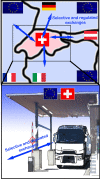Blood-brain borders: a proposal to address limitations of historical blood-brain barrier terminology
- PMID: 38183042
- PMCID: PMC10770911
- DOI: 10.1186/s12987-023-00478-5
Blood-brain borders: a proposal to address limitations of historical blood-brain barrier terminology
Abstract
Many neuroscientists use the term Blood-Brain Barrier (BBB) to emphasize restrictiveness, often equating or reducing the notion of BBB properties to tight junction molecules physically sealing cerebral endothelial cells, rather than pointing out the complexity of this biological interface with respect to its selectivity and variety of exchange between the general blood circulation and the central nervous tissue. Several authors in the field find it unfortunate that the exquisitely dynamic interfaces between blood and brain continue to be viewed primarily as obstructive barriers to transport. Although the term blood-brain interface is an excellent descriptor that does not convey the idea of a barrier, it is important and preferable for the spreading of an idea beyond specialist communities to try to appeal to well-chosen metaphors. Recent evidence reviewed here indicates that blood-brain interfaces are more than selective semi-permeable membranes in that they display many dynamic processes and complex mechanisms for communication. They are thus more like 'geopolitical borders'. Furthermore, some authors working on blood-brain interface-relevant issues have started to use the word border, for example in border-associated macrophages. Therefore, we suggest adopting the term Blood-Brain Border to better communicate the flexibility of and movement across blood-brain interfaces.
Keywords: Blood–brain barrier; Blood–brain border; Blood–brain interface; Immune system; Neurovascular unit; Transport.
© 2023. The Author(s).
Conflict of interest statement
The authors declare no competing interests. Robert G Thorne is a paid employee of Denali Therapeutics.
Figures



References
-
- Stern L, Gautier R. Recherches sur le liquide céphalo-rachidien: I. Les rapports entre le liquide céphalorachidien et la circulation sanguine. Archiv Int Physiol. 1921;17(2):138–92.
Publication types
MeSH terms
Grants and funding
LinkOut - more resources
Full Text Sources

